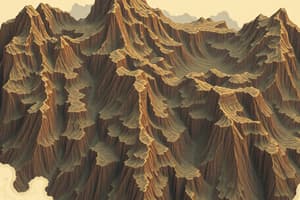Podcast
Questions and Answers
What are the different types of landforms?
What are the different types of landforms?
- Continents, countries, states, cities, towns
- Forests, grasslands, tundras, rainforests, deserts
- Mountains, valleys, plains, islands, peninsulas (correct)
- Rivers, lakes, oceans, glaciers, deserts
Landforms can affect human activity, but human activity cannot impact landforms.
Landforms can affect human activity, but human activity cannot impact landforms.
False (B)
What is the theory of plate tectonics?
What is the theory of plate tectonics?
The theory of plate tectonics states that the Earth's outer layer is divided into plates that move slowly, and their interaction shapes the Earth's surface.
What are the forces that shape the Earth's landforms?
What are the forces that shape the Earth's landforms?
What are the three layers of the Earth?
What are the three layers of the Earth?
Flashcards
What are landforms?
What are landforms?
Shapes on Earth's surface, like mountains, valleys, plains, islands, and peninsulas.
What are continents?
What are continents?
Large landmasses on Earth, like North America or Asia.
What is plate tectonics?
What is plate tectonics?
The theory that Earth's outer layer is made up of large plates that move slowly over time.
What is lava?
What is lava?
Signup and view all the flashcards
What are earthquakes?
What are earthquakes?
Signup and view all the flashcards
What is weathering?
What is weathering?
Signup and view all the flashcards
What is erosion?
What is erosion?
Signup and view all the flashcards
What is alluvial deposition?
What is alluvial deposition?
Signup and view all the flashcards
What does plate tectonics explain?
What does plate tectonics explain?
Signup and view all the flashcards
What are Earth's three layers?
What are Earth's three layers?
Signup and view all the flashcards
How do Earth's tectonic plates move?
How do Earth's tectonic plates move?
Signup and view all the flashcards
What causes tectonic plates to move?
What causes tectonic plates to move?
Signup and view all the flashcards
What does the world map with colored plates show?
What does the world map with colored plates show?
Signup and view all the flashcards
Why are the boundaries between tectonic plates important?
Why are the boundaries between tectonic plates important?
Signup and view all the flashcards
What happens when tectonic plates collide?
What happens when tectonic plates collide?
Signup and view all the flashcards
What happens when tectonic plates separate?
What happens when tectonic plates separate?
Signup and view all the flashcards
What happens when tectonic plates slide past each other?
What happens when tectonic plates slide past each other?
Signup and view all the flashcards
What is the significance of tectonic plates in shaping Earth's surface?
What is the significance of tectonic plates in shaping Earth's surface?
Signup and view all the flashcards
What do geographers study?
What do geographers study?
Signup and view all the flashcards
Study Notes
Earth's Landforms
- Landforms are shapes on Earth's surface, like mountains, valleys, plains, islands, and peninsulas.
- Mountains rise above 2,000 feet (610 meters).
- Valleys are low areas between mountains or hills.
- Plains are flat stretches of land.
- Islands are land surrounded by water.
- Peninsulas are land surrounded by water on three sides.
Plate Tectonics
- Earth's crust is made of plates that move, typically several inches a year.
- Plate movement creates forces that form many landforms.
- Plates collide, separate, and slide past each other, creating these forces.
- Earth's structure is divided into a core, mantle, and crust.
- The crust is the outer layer, and continents are part of this.
Forces Shaping Landforms
- Plate tectonics explains how forces within Earth shape landforms.
- Energy deep within the Earth puts pressure on Earth's crust, causing it to shift, ultimately moving the plates.
- These plate movements can create various landforms based on the direction and speed of this movement.
- Scientists study how landforms interact with and impact human activity.
Studying That Suits You
Use AI to generate personalized quizzes and flashcards to suit your learning preferences.




